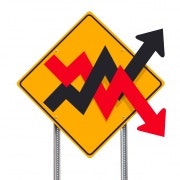Australian market gets expensive
PORTFOLIO POINT: The Australian market has rallied in spite of falling earnings forecasts. We’re now looking pretty expensive against other markets.
Australian consensus earnings forecasts keep falling. The ASX200 rallied 15% from June to October, despite falling earnings forecasts. The result is a market that now looks expensive relative to global peers.
Analysts continue to revise down their earnings forecasts for Australian corporates. Mining-sector earnings have fallen with commodity prices. As importantly, downgrades in non-mining sectors have been as severe over the past year as anything seen outside the Global Financial Crisis (Exhibit 1).
Mining-sector forecasts are in full retreat (Exhibit 2). Earnings per share (EPS) for the 2012 financial year has ended lower than FY2005, although commodity prices are now, on average, much higher than in 2005. Downgrades may moderate now that spot commodity prices have stabilised.
Although not as rapid, banks’ EPS forecasts are also coming down (Exhibit 3 – although this chart won’t reflect any forecast changes following this week’s NAB result).
The pattern of earnings revisions in Australia reflects the global pattern. The Materials sector has seen the largest downgrades of any top-level GICS sector. Metals & Mining, a component of Materials, has seen even larger downgrades (Exhibit 4). Most other cyclical sectors have seen either small downgrades or, in the case of Technology, upgrades through this year.
Australia has a mining-heavy/technology-light index. This in part explains why market-wide EPS forecasts for the ASX200 have been cut more than almost every other market in the world, including Europe (Exhibit 5).
The rally in the ASX200 from early June has reflected price earnings expansion (as has the rally globally). The prospective PE increased by 15% from the June low, explaining all the price increase. The largest PE expansion in the Australian market has been for consumer discretionary stocks (Exhibit 6).
Some forward-looking points:
1. If we see better growth from China through 2013, and industrial commodity prices stabilise or rise, then the global mining sector looks a relatively ‘safe’ cyclical. Global mining has seen substantial downgrades and is under-owned. I don’t have great data on positioning in Australia, but my sense is that investors are likewise underweight.
2. The outlook for domestic banks will darken if unemployment starts to rise in Australia. Richard Wiles of Morgan Stanley’s equity research team is arguing that the credit cycle is worsening. Banks have benefitted from the hunt to yield and are arguably over-owned domestically. However, the yield now reflects a high pay-out ratio (dividends as a share of reported earnings). Risks around the dividend yield would increase if unemployment rises, and the credit cycle deteriorates, over the next 12-24 months.
3. The potential mix of Chinese revival and domestic weakness points to investors swinging from banks to miners – effectively reversing the big trade of the past year.
4. While there may be a rotation trade within the Australian market, the overall market looks expensive. Its prospective PE is now in line with the S&P500, which is arguably the world’s most expensive major market (Exhibit 7).
Worse, the Australian market is even more expensive once account is taken of its sector composition. The ASX200 is overweight sectors that globally trade on low PE multiples (such as financials) and underweight sectors that trade on high PE multiples (technology). There are obviously reasons why, for example, Australian banks trade at a premium to their global peers. But the point remains that on a like-for-like sector weighting, the ASX is even more expensive relative to other global markets than the simple PE suggests. With sectors reweighted to reflect the S&P500 weights, for example, the ASX now trades at a 20% PE premium to the SPX (Exhibit 8).
Gerard Minack is head of global developed market strategy at Morgan Stanley.
























